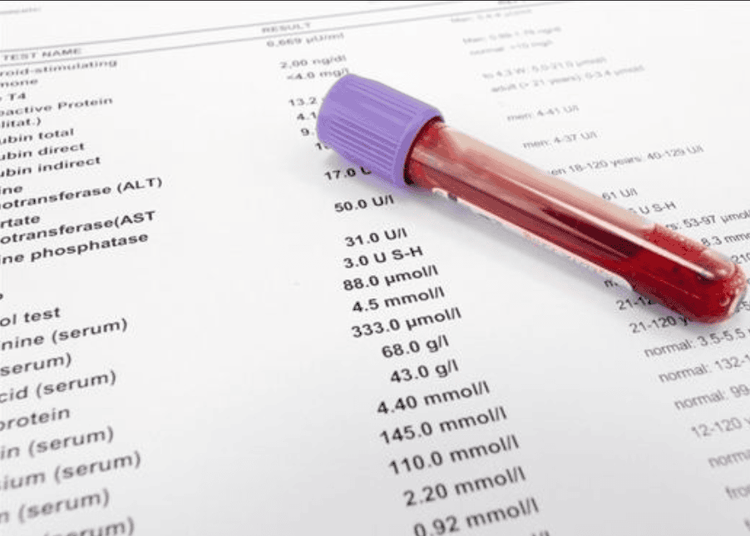This is an automatically translated article.
Posted by Doctor Tran Thi Huyen Trang - Laboratory Department - Vinmec Times City International Hospital
Early diagnosis of preeclampsia is extremely important to help doctors manage, care for and intervene accurately and promptly, bringing the best benefits to both mother and baby.
1. What is preeclampsia (TSG)?
Preeclampsia (TSG) is defined as new-onset hypertension associated with proteinuria, or in the absence of proteinuria, preeclampsia is defined as high blood pressure with the following relationship: Thrombocytopenia, renal failure , liver failure , pulmonary edema , cerebral or visual symptoms, onset after 20 weeks of pregnancy.
Every year 10 million women have preeclampsia or other hypertensive disorders associated with pregnancy, of which about 76,000 deaths are related to preeclampsia and about 500,000 children die of preeclampsia each year. Early diagnosis of preeclampsia is extremely important to help doctors manage, care and intervene accurately and promptly, bringing the best benefits to both mother and baby.

Tiền sản giật là do rối loạn huyết áp thai kỳ kết hợp với một số bệnh khác gây ra
2. Strategies for managing preeclampsia during pregnancy
Screening for preeclampsia in the first trimester The 11-14 week screening identifies high-risk pregnant women with an algorithm that includes MAP (Mean arterial pressure), UTPI (Mean uterine artery PI) and PlGF:
High-risk group develops Pre-eclampsia development before 37 weeks ≥1/100 (accounting for about 10% of pregnant women). Treatment with aspirin (150 mg/day) at bedtime for 12 to 36 weeks reduces the risk of preterm preterm preeclampsia by 60%. ), less likely to develop preeclampsia <37 weeks, but risk reassessed at 22 weeks. Management of pre-eclampsia in the second trimester Using two tests sFlt-1 and PlGF at 20-24 weeks:
High-risk group develops pre-eclampsia before 32 weeks ≥1/100 accounts for about 1% of pregnant women, needs to be monitored Regular monitoring by measuring blood pressure, urinalysis and ultrasound monitoring fetal growth at about 24-31 weeks. Low-risk group developing preeclampsia before 32 weeks <1/300). This group, which accounts for >80% of pregnancies, is less likely to develop preeclampsia <36 weeks, but risk reassessment at 36 weeks is needed. The intermediate risk group (between the two groups above) accounted for <20% of the total number of pregnant women and >90% of these women developed preeclampsia between 32-35 weeks. Risk reassessment at gestational age 32 is needed. the week .

Tiến hành các xét nghiệm quản lý TSG trong suốt thai kỳ
Management of pre-eclampsia in the third trimester Using two tests sFlt-1 and PlGF
Week 32:
High-risk group develops preeclampsia before 36 weeks ≥1/100: accounted for about 3% of pregnant women and about 90% of women in this group develop preeclampsia at 32-36 weeks, need to be monitored regularly by measuring blood pressure, urinalysis and ultrasound to monitor fetal growth
Low risk group (risk of preeclampsia before 36) week <1/300). accounted for > 80% of pregnant women, less likely to develop pre-eclampsia <36 weeks, but need to reassess risk at 36 weeks.
Week 36:
High-risk group develops preeclampsia before 40 weeks ≥1/100: accounts for about 20% of pregnant women and about >90% of women in this group develop preeclampsia <40 weeks, need to be closely monitored
Low-risk group developing preeclampsia before 42 weeks <1/200): accounts for about 40% of all pregnant women > 99.9% chance of not developing preeclampsia, if there are no obstetric indications, it is possible continue monitoring to wait for natural labor .
Moderate risk group: 60% of pregnant women at risk of developing preeclampsia >40 weeks need re-evaluation at 40 weeks to decide the most appropriate time for labor.
Support short-term diagnosis and prognosis using the ratio sFlt-1/PlGF from 20 weeks of pregnancy with high-risk subjects:
Pregnant women with signs and symptoms suggestive of preeclampsia (CHA) new, new proteinuria, epigastric pain, headache, visual disturbances, edema, Doppler abnormalities (≥ 95th percentile), abnormal weight gain, ..) Pregnant woman has been identified as Pre-eclampsia (based on criteria classical diagnostic criteria CHA and proteinuria) Diagnosis of preeclampsia when sFLT-1/PLGF ratio
>= 85 with early preeclampsia (onset before 34 weeks)
>= 110 with early preeclampsia (onset after 34 weeks)
Retest after 2-4 days to guide
Prognosis of preeclampsia (Late-onset) in “Suspected preeclampsia” group:
Ratio of sFLT-1/PLGF >=655 🡪 related to the possibility of termination of pregnancy in 48h.

Phù chân trong thai kỳ có thể là dấu hiệu tiền sản giật
3. TSG screening service is being performed at Vinmec
12 week maternity care program:
Includes blood collection for Double test and quantification of angiogenic factor PLGF to screen for 3 Down syndrome, Edward, Patau syndrome for fetus and prenatal screening week 12 convulsion for mothers Pre-eclampsia screening from 20 weeks with sFLT-1 and PLGF test kits At Vinmec International General Hospital, screening tests for TSG were performed on the Cobas 8000 system, using raw materials. Electro-luminescence management, fully automatic for fast and accurate results, ensuring that pregnant women with pre-eclampsia are not missed, helping obstetricians and gynecologists make timely decisions, bringing optimal benefits to both mother and baby. . These two Roche tests have been certified for test quality by the Fetal Medicine Foundation (FMF) and can use FMF software to help assess the risk of TSG with global quality.
At Vinmec International General Hospital, there is a package maternity service as a solution to help pregnant women feel secure because of the companionship of the medical team throughout the pregnancy. When choosing Maternity Package, pregnant women can:
The pregnancy process is monitored by a team of qualified doctors Regular check-up, early detection of abnormalities Maternity package helps to facilitate the process. birth process Newborns receive comprehensive care Recommended video:
Common diseases in pregnancy and ways to prevent
Please dial HOTLINE for more information or register for an appointment HERE. Download MyVinmec app to make appointments faster and to manage your bookings easily.













